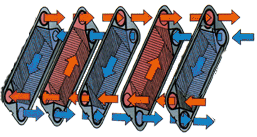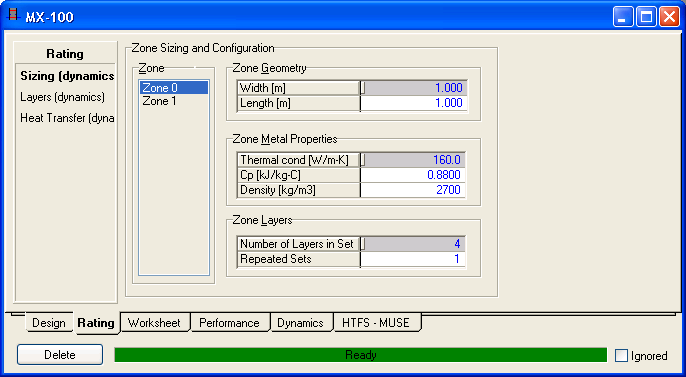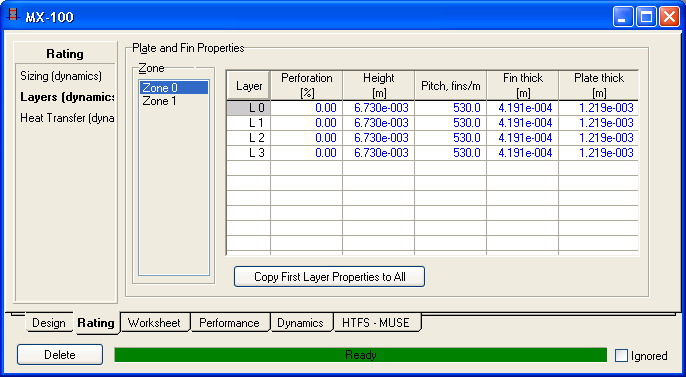Multistream Heat Exchanger
Introduction
These heat exchangers consist of thin chambers separated by plates that route fluid through alternate hot and cold passages. Heat is transferred via the fins through the metal between the fluids.

Rating
Steady state solves the LNG by relying on a number of specifications such as UA, temperature or duty specifications. But dynamics mode provides a powerful robust fairly rigorous rating model. The model can be used for plate fin exchangers.
The model can be split into a number of zones (sections if you will), and a set of equations is written for each zone. Fluids can flow from a layer in one zone to a layer in another zone, and an external stream can enter into or exit from any zone.

The sizing page allows the physical size of the zone (think of it a plate fin metal block) to be specified, as well as the properties of the metal.
For each zone a number of layers is set up, which provides a pattern for how stream are inside inside the unit. If the exchanges has only two streams, the set will likely have two layers since hot and cold will alternate. The set then repeats a large number of times. The total number of metal layers is equal to the number of sets multiplied by the number of layers in the set.

For each layer in the repeating set, the properties can be specified. These include perforation, height, fin pitch, fin thickness and plate thickness. These values impact the heat transfer area and geometry.

This page determines the heat transfer coefficients. These are typically specified and scaled based on the flow rate. They can also be calculated by setting the "U Calculator" to "Hysim Correlation". The area is automatically determined from other information provided.
Since the LNG can model startup and shutdowns and flow reversals and very low temperatures, reference flows should be provided.
Performance

The summary view can be used to get a quick overall look at what is happening inside the various layers and zones. It shows the temperatures of the fluids entering and leaving each layer.

The layers view shows even greater detail of a specific heat transfer point. Pressing Diagram shows detailed temperatures and duties at a specific point inside the model.
Model

The number of zones determines how many metal blocks, if you will, the exchanger has. Additional zones can be added for greater rigour. The zone is made of of a number of sets of layers that repeated. The number of layers in the set determine how the fluids are arranged inside the block. Typically a hot stream is located next to a cold stream.
For example, if the exchanger has two fluids, A and B, they will typically be arranged in alternate layers of hot, cold, hot, cold, hot, cold etc. One zone with two layers repeating can then set up. The same fluid may appear multiple times in the pattern , and possible have different temperatures in the different layer depending on its connections. By default each layer in the pattern is modeled in detail with a separate volume and set of heat transfer equations. The Combine Layers option can be used to combine these model entities for layers that contain the same fluid.
If the model is fully flexible in terms of zone and how they are connected. Some exchangers have very complex arrangements with some fluids passing through the entire exchanger and some only being present in certain zone. Each layer must have a feed and product connect. Each can be either an external stream connected to the exchanger, or another layer in any zone.
Click Auto Connect to automatically connect stream and layers to the zones, using a very simple approach. This is often handy to provide some initial values.
Specifications

A pressure drop calculator can be selected for each layer. As discussed, for most realistic results, this should be set to "not specified" and the Flow Equation option checked for all layers and all zones. K values can be calculated by specifying a value for Delta P and then pressing Calculate K's. If the Laminar option is checked it means that the flow rate is proportional to the frictional pressure gradient, rather than the square root of it.
< Heat Exchanger | Index | Heater Cooler >